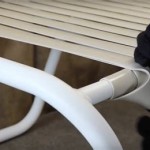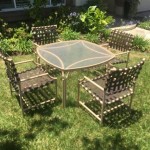How To Repair Plastic Wicker Patio Furniture
Plastic wicker patio furniture offers a blend of aesthetic appeal, durability, and affordability, making it a popular choice for outdoor spaces. However, despite its inherent resilience, plastic wicker is susceptible to damage from prolonged exposure to the elements, physical stress, and general wear and tear. Understanding how to properly repair damaged plastic wicker can significantly extend the lifespan of patio furniture, saving money and minimizing waste. This article provides a comprehensive guide to common plastic wicker repair techniques, covering everything from identifying the type of damage to executing effective repair solutions.
Before initiating any repair, it's crucial to identify the type of plastic used in the wicker. The most common materials include polyethylene (PE), polypropylene (PP), and polyvinyl chloride (PVC). PE wicker is generally more flexible and resistant to cracking, while PP offers superior strength and heat resistance. PVC, though less common in high-end furniture, is often found in budget-friendly options. The specific type of plastic will influence the choice of repair method and the adhesives or tools required. A visual inspection coupled with any product information available can help determine the material composition. If uncertain, testing a small, inconspicuous area with different adhesives can provide valuable insights before committing to a full-scale repair.
Identifying Common Types of Damage
Recognizing the specific type of damage plaguing the plastic wicker is the first step towards a successful repair. Common issues include: broken strands, unraveling weaves, sagging or stretched sections, discoloration or fading, and frame damage compromising the wicker's structural integrity.
Broken Strands: These are perhaps the most frequent occurrences. They can result from sharp impacts, excessive weight, or simply the gradual weakening of the plastic due to ultraviolet (UV) radiation. Broken strands detract from the furniture's appearance and can potentially lead to further unraveling if left unattended.
Unraveling Weaves: This problem arises when the interlocking pattern of the wicker becomes disrupted, typically at the edges or corners. Unraveling can be caused by broken strands, loose fasteners, or the deterioration of the binding agents holding the weave together. Early intervention is key to prevent the unraveling from spreading and compromising larger sections of the furniture.
Sagging or Stretched Sections: Over time, the weight of occupants can cause the plastic wicker to stretch and sag, particularly in seating areas. This is more common in furniture with wider weaves or those constructed from less durable plastics. Sagging not only affects the aesthetic appeal but also reduces the support and comfort provided by the furniture.
Discoloration or Fading: Prolonged exposure to sunlight can cause the plastic to fade or discolor, creating an uneven and unattractive appearance. While this doesn't necessarily affect the structural integrity of the wicker, it can significantly diminish its aesthetic value.
Frame Damage: The wicker weave is typically supported by a metal or wooden frame. Damage to this frame, such as rust, corrosion, or breakage, can compromise the structural integrity of the entire piece of furniture. Addressing frame damage is often more complex than repairing the wicker itself and may require specialized tools and expertise.
Essential Tools and Materials
Equipping oneself with the right tools and materials is crucial for undertaking any plastic wicker repair project. The specific items needed will depend on the type of damage encountered and the chosen repair method. However, some essentials include:
Replacement Wicker Strands: Matching the original wicker in terms of color, width, and material is paramount. Many online retailers specialize in replacement wicker strands, offering a wide selection of options. Ordering slightly more than estimated is recommended to account for mistakes or future repairs.
Adhesive: Selecting the appropriate adhesive is critical for bonding plastic wicker effectively. Cyanoacrylate adhesives (super glue) work well for small breaks, but epoxy resins are generally more durable and suitable for larger repairs. Consider a flexible adhesive specifically designed for plastics to accommodate movement and prevent cracking. Always verify that the chosen adhesive is compatible with the type of plastic being repaired.
Cutting Tools: A sharp utility knife or scissors is essential for trimming replacement wicker strands and removing damaged sections. Specialized wicker cutting tools are also available for more precise and efficient cutting.
Pliers and Needles: Pliers are useful for gripping and manipulating wicker strands, while needles can assist in weaving and securing the strands in place. A pair of needle-nose pliers is particularly helpful for working in tight spaces.
Sandpaper or Abrasive Pads: Sandpaper or abrasive pads can be used to smooth rough edges and prepare surfaces for adhesive application. Different grits of sandpaper may be needed for varying levels of abrasion.
Cleaning Supplies: Before commencing any repair, thoroughly clean the affected area with soap and water to remove dirt, debris, and any residual oils. Isopropyl alcohol can also be used to degrease the surface and promote better adhesion.
Clamps or Weights: Clamps or weights can be used to hold repaired sections together while the adhesive cures. This ensures a strong and durable bond.
Color Matching Pens or Paints: For minor discoloration or fading, color-matching pens or paints can be used to touch up the affected areas. Choose products specifically designed for use on plastics and follow the manufacturer's instructions carefully.
Step-by-Step Repair Techniques
Once the damage has been identified and the necessary tools and materials have been gathered, the repair process can begin. The following provides a detailed breakdown of repair techniques for various types of plastic wicker damage:
Repairing Broken Wicker Strands:
1. Clean the area around the break with soap and water, then dry thoroughly.
2. Apply a small amount of flexible plastic adhesive to both ends of the broken strand.
3. Carefully align the broken ends and press them together firmly.
4. Use clamps or tape to hold the pieces together while the adhesive cures according to the manufacturer's instructions. Excess adhesive should be wiped away immediately using a clean cloth and appropriate solvent, if recommended by the adhesive manufacturer.
5. If the break is severe or the strand is missing a large section, a replacement strand will be needed. Measure the length of the missing section and cut a replacement strand slightly longer. Weave the replacement strand into the existing weave pattern, securing the ends with adhesive. The weave pattern may need to be replicated by careful observation of the furniture's design.
6. After the adhesive has cured, trim any excess material with a sharp utility knife.
Repairing Unraveling Weaves:
1. Identify the loose or broken strands causing the unraveling.
2. If the strand is broken, repair it using the method described above. If the strand is simply loose, carefully re-weave it back into the original pattern. Using a needle or small pliers can help manipulate the strand through tight spaces.
3. Apply a small amount of adhesive to the point where the strand is re-secured to prevent further unraveling. Clamps or tape can be used to hold the weave in place while the adhesive cures.
4. For extensive unraveling, it may be necessary to remove and replace a larger section of the weave. This involves carefully cutting out the damaged section and weaving in a new piece of wicker, securing it with adhesive at all points of contact. The weave pattern must match exactly to restore both stability and appearance.
Addressing Sagging or Stretched Sections:
Repairing sagging or stretched sections is often more challenging, as it involves restoring the elasticity of the plastic wicker. In some cases, the damage is irreversible and replacement of the entire section may be necessary.
1. For minor sagging, applying heat to the affected area may help to shrink the plastic back to its original shape. A heat gun should be used carefully, keeping it at a safe distance to avoid melting or scorching the plastic. Move the heat gun slowly and evenly over the surface, checking the progress frequently.
2. Adding additional support underneath the sagging section can also help to improve its stability. This can be done by attaching a piece of plywood or metal mesh to the frame beneath the wicker. Ensure the support is firmly attached to the frame and does not interfere with the overall design of the furniture.
3. If the sagging is severe, replacing the entire section of wicker may be the only viable option. This involves removing the damaged section and weaving in a new piece of wicker, ensuring that it is tightly woven and securely fastened to the frame. Paying careful attention to the tension applied during weaving is key to prevent future sagging.
Restoring Discoloration or Fading:
1. Clean the affected area thoroughly to remove any dirt or debris.
2. Apply a color-matching pen or paint to the faded areas, following the manufacturer's instructions carefully. Using multiple thin coats is often more effective than applying one thick coat.
3. Allow the paint to dry completely before using the furniture. For added protection, consider applying a UV-resistant sealant to prevent future fading.
4. For significant fading, consider using specialized plastic restorers designed to revive the color and luster of the material. These products often contain UV inhibitors to protect against further damage.
Repairing Frame Damage:
Frame repairs vary greatly depending on the material of the frame (metal, wood, etc.) and the nature of the damage (rust, breakage, etc.). Metal frames can often be repaired by welding or patching corroded areas. Wooden frames can be repaired by gluing or replacing damaged sections. Due to the complexity, this often needs more specialized skill or outsourcing to a professional.
1. Assess the extent of the damage to the frame. Is it a simple crack, or is there significant rust or rot?
2. Clean the area around the damage thoroughly. Remove any rust or loose wood.
3. Depending on the type of frame, use the appropriate repair method. For metal frames, welding or epoxy patching may be necessary. For wooden frames, wood glue and clamps may suffice for minor cracks. Severely damaged wooden sections may need to be replaced.
4. Once the frame repair is complete, protect it with a suitable sealant or paint to prevent further damage. Apply rust-inhibiting paint to metal frames and wood preservative to wooden frames.
By implementing these repair techniques, individuals can effectively extend the lifespan of their plastic wicker patio furniture, preserving its aesthetic appeal and functionality for years to come. Regular maintenance, including cleaning and protecting the furniture from the elements, can further minimize the need for repairs and ensure long-lasting enjoyment.

Fixing Outdoor Rattan Furniture A Pretty Life In The Suburbs

Resin Wicker Patio Furniture Unraveling Hometalk

How To Repair Resin Wicker Chairs Using Glue Gun Atc Furniture 2024

How To Fix The L Off Broken Weaving Of Chair

Wicker Furniture Repair Guide Jessica Welling Interiors

How To Repair Plastic Wicker Furniture 7 Easy Steps

How To Repair Your Resin Wicker Outdoor Furniture Doityourself Com

How To Repair Plastic Wicker Furniture 7 Easy Steps Fix

Fix Rattan Garden Furniture Resin Wicker Repair Outdoor

Wicker Repair Kit Plastic Synthetic Rattan Material Supplies Furniture Replacement Patio Chair Table Sofa Com
See Also








